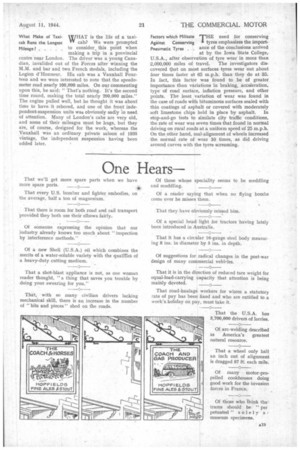Passing Comments L.P.T.B. Inspectors are THAT London Transport's Functioning as
Page 20

Page 21

If you've noticed an error in this article please click here to report it so we can fix it.
Bomb I bus inspectors should act as Spotters spotters of flying bombs is a
practical idea and one that both drivers and conductors will appreciate. The driver has little chance of taking evasive action, as he cannot hear their approach, but with suitable indication of their direction of travel he can either. " step on it " or pull up, as circumstances demand. We must give a word of high praise for the clippies, who do not seem to care so much for their own safety as for that of their fares. On several occasions we have been able to shield ourselves from bus windows as a result of a warning, delivered like a command, from these gallant women.
Accidents in America THE safety section of the Caused by Mechanical I I.C.C. Bureau of Motor Defects Carriers some time ago analysed the main causes of vehicle accidents resulting from mechanical defects. This covered experience in 1941, and concerned a total of 839 of such accidents. Of these, 308 were attributed to defects in brakes. Put another way, such faults were four times more numerous than the next most-frequently reported trouble. Accidents resulting from tyre, engine and steering defects were about 9 per cent each, In one-third of the cases where failure of the steering mechanism was an element there was no certain knowledge .as to what £18 caused the defect, but in nearly a quarter of them locking of binding of the mechanism was given as the reason, which strongly indicates maladjustment and/or improper lubrication. The remainder of the accidents was occasioned by the breaking of various parts of the steering, such as knuckles, arms, or drag links. , Many of the defects were of such a nature that they would have been discovered had adequate inspection been made. The • magnetic method of examining stressed parts at intervals was recommended.
Regular Service
in Australia . . . . AWRITER to "Truck and
trade journal of Australian road transport, states, in a Bus Transportation," the recent issue, that he is driving a 1918 model Vulcan 2-tonner with solid tyres. The usual load is 4i tons, although, occasionally, the vehicle carries up to 5 tons, which, he says, speaks well for this venerable British product. The only trouble experienced as a result of this overloading is broken centre bolts in the front springs; they are sometimes sheared off by the heavy jolting caused by travelling fast over bad roads. Oil consumption is rather heavy, being about a gaflonand-a-half per day. Fuel consumption is not very good, owing to frequent stops, but is no more than in many of the other vehicles of various types. We consider that such a record will require a considerable amount of beating. WHAT is the life of a taxi" cab? We were prompted to consider, this point when making a trip in a provincial centre near London. The driver was a young Canadian, invalided out of the Forces after winning the M.M. and bar and two French Medals, including the Legion d'Honneur. His cab was a Vauxhall Fourteen and we were interested to note that the speedometer read nearly 100,000 miles. On our commenting upon this, he said: "That's nothing. It's the second time round, making the total nearly 200,000 miles." The engine pulled well, but he thought it was about time to have it rebored, and one of the front independent-suspension units was obviously sadly In need of attention. Many of London's cabs are very old, and some of their mileages must be huge, but they are, of course, designed for the work, whereas the Vauxhall was an ordinary private saloon of 1935 vintage, the independent suspension having been added later. What Make of Taxicab Runs the Longest Mileage ? Factors which Militate THE need for conserving Against Conserving I tyres emphasizes the importPneumatic Tyres . . ance of the conclusions arrived at by the Iowa State College, U.S.A., after observation of tyre wear in more than
2,000,000 miles of travel. The investigators discovered t,hat on most surfaces tyres wear out about four times faster at 65 m.p.h. than they do at 35. In fact, this factor was found to be of greater importance than variations in braking, acceleration, type of road surface, inflation pressure, and other points. The least variation of wear was found in the case of roads with bituminous surfaces sealed with thin coatings of asphalt or covered with moderately soft limestone chips held in place by asphalt. In stop-and-go tests to similate city traffic conditions, the rate of wear was seven times that found in normal driving on rural roads at a uniform speed of 25 m.p.h. On the other hand, mal-alignment of wheels increased the normal rate of wear 10 times, as did driving around curves with the tyres screaming.




















































